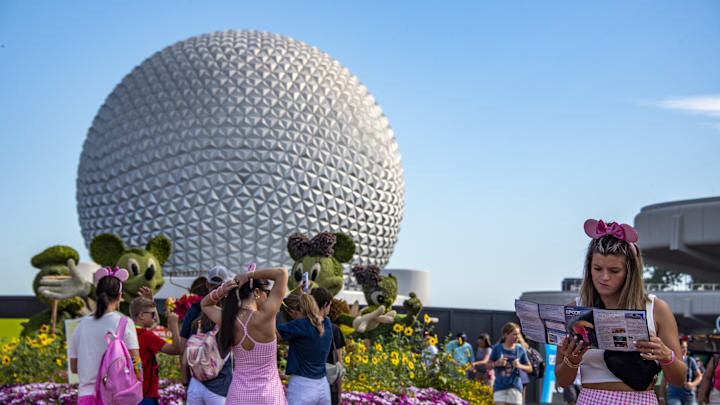There’s been talk over the last year that by the end of 2024, Disney will be completely removing paper park maps. It’s easy to see the logic as those are a hassle to keep printing constantly, frequently changing it for new attractions and environmental concerns. There’s also how the various apps allow folks to not only look at a map on the phone but also get to see how long lines are for rides. So, for a new generation, not having to bother unfolding those big paper maps is a lot easier.
But those who ignore it also ignore the wonderful history such maps contain, not just for your current trip but for the future. Disney maps have changed a lot over the years, but the charm of them still remains. They’ve gone from standard theme park maps to some lovely artwork and not just important for getting around the parks but also a free souvenir of your travels and a time capsule of how the parks once were.
I can still remember first visiting Walt Disney World in 1984 with those bright maps, one for Magic Kingdom and the other for EPCOT Center. Each was colorful and not just on the outside. The Magic Kingdom was great, with each land color-coded: red for Main Street, green for Adventureland, brown for Frontierland/Liberty Square, yellow for Fantasyland and purple for Tomorrowland. When Mickey’s Starland (later Toontown Fair) was added, it was pink.
Going deeper, each land had its own page with numbering and coloring marking between major rides, restaurants and shops. There were also the little Kodak symbols indicating great places to take a photograph, from bridges to in front of Cinderella’s Castle. The little character drawings for each land were also a nice touch.
For EPCOT, each pavilion was highlighted with the main attraction/ride in red and green/blue for shops and restaurants. When MGM Studios came along, each section was likewise color-coded. They weren’t just maps but guidebooks with pages of information from lost and found to other services, needed in the days before folks had phones with such information at their fingertips.
The evolution of the maps
It was always fun to see the maps change over time, usually the cover photo marking a new attraction like Splash Mountain. Starting in 1991, they sparked the exterior up, making them flashier, often different colors for each park. Another change occurred in 1994 with Epcot renamed and the maps themselves shifting, doing away with the specific pages for each attraction and thus not as large as they once were.
The park drawings became more lively, capturing the attractions in brighter ways rather than the staid symbols they’d been before. By the time Animal Kingdom came along, the maps had done away with the color coding system but made up for it with the gorgeous detail of the main map with the unfolded pages marking the various shops and restaurants.
There was also the change from putting them out every few months to freshening them up weekly and now having schedules of shows or special events. Thus, you always knew when your vacation took place by the map you had, and Disney smart to shift them up (such as Christmas-themed for the holidays).
Besides the maps, there were also huge brochure-style guides to the parks, often offered at the Orlando airport or some hotels, meant to entice folks to visit. These could be even more fun, short but showed Disney put care into making folks feel welcome and part of the experience the moment they stepped through the gates.
Keeping them as a memory
That is the most underrated part of the maps: They’re the best free souvenir of a Disney trip you could have. Personally, one of the first things I did was to collect those guides and pocket a couple of maps too. Even if I knew the park well, it was great to have these as a collectible for the trip and still several of them in my home from over the years. Admittedly, it’s not just Disney, I’ve done it for Universal and other parks but Disney remains the tops.
They’re a reminder of rides long gone from Horizons to Mr. Toad and the excitement of new attractions opening. There was also the fun when it was a special anniversary from the 25th birthday of WDW in 1996 to the recent 100 Years of Wonder at Disneyland.
Sure, having the Disneyland app to check the parks and see the wait times is great. But that paper map was just as useful for my family to get around. Amazingly, there are folks who don’t use apps and prefer the classic paper maps to know where to go in the park. At the end of the day, it’s bringing those maps home to remind one of their Disney trip that is a reason Disney hopefully backs out of this plan as paper maps, like a lot of print media, are far more long-lasting than a digital map and a magic that shouldn’t be lost to time.
